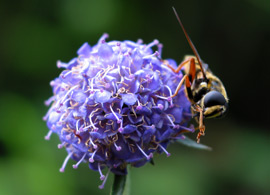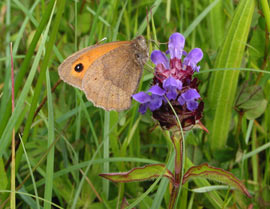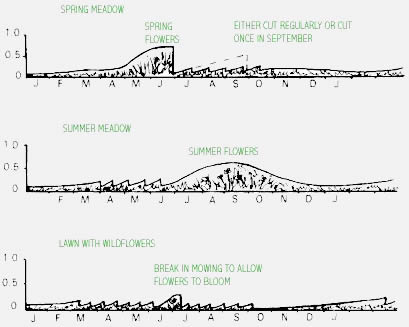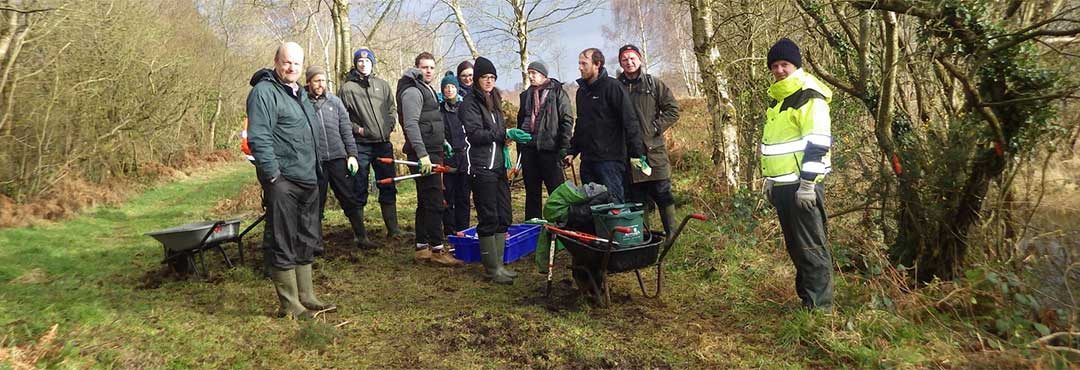
Colourful wildflowers are an increasingly rare sight in our countryside, lost largely through ‘improvements’ in farming practices.
There are many reasons to recreate environments for these plants. They provide an ever-changing source of fascination, beauty and pleasure, and a species-rich grassland becomes home to a great deal of wildlife, including insects and butterflies, birds and mammals. Wildflower areas can also be an educational resource for all ages, offering much to see and to learn.
Selecting a site
Wildflower areas can be created on a variety of sites, including roadside verges, parks, school grounds, community gardens, waste ground, small backyards, or any other available space. In general, sites with low fertility are preferred, as this reduces the competition from more vigorous species. Find out whether your site is sunny or shaded, wet or relatively dry, and select species to suit. It is important to assess what is already on your site, preferably by observing it over a year, so that you do not destroy any existing ecological features of interest and know what weed problems you might have.
How to start

If you are starting with an area of non-vigorous grasses (check this first), cut the grass down to 5cm, remove the clippings, and introduce new species as plugs planted into holes. Autumn is the best time to do this so that roots can become established before strong competition builds up in spring. Water plugs before planting. It may be necessary to keep weeding until the plants are established, and water after planting and throughout the first summer if the weather is dry.
If you are starting with a bare area or you wish to replace a lawn or other existing vegetation, you may want to remove the topsoil to lower the fertility. Plugs can then be planted at a spacing of ten per square metre. Several plugs of each species should be planted close together, to facilitate pollination in the first year or two until the plants get established.
Selecting Species
In the selection of species for your meadow, it is important to select only species which are native to Northern Ireland, that is, those which are naturally found here. These are the most likely to be successful, and also have a much higher wildlife value than so-called ‘exotics’. Some species of native wildflower can support several hundred different insect species along with those animals that feed on the insects: normally more than any non-native species can support. There are even some insects which require one particular foodplant for its larvae, always native, and which will not survive without it. If possible, find a supplier who can guarantee that the seed for your wildflowers was collected locally, as there are some genetic differences even within the same species between seed from Northern Ireland and that from elsewhere.
Meadows are a mixture of grasses and broadleaved plants, but care must be taken to ensure that the grasses are not too competitive. Rye grass, commonly used for garden lawns, is unsuitable. A mixture of bents and fescue grasses is best, along with some of the more unusual species such as meadow foxtail, smooth meadow grass and sweet vernal grass.
Management
In order to understand why a natural ecological community such as a wildflower area needs to be managed, it is necessary to examine where meadows occurred in the past. Traditionally, a meadow was an area on which a crop of hay was grown and harvested for animal food, while a pasture was grazed directly by animals. A common feature of both of these land uses is that the vegetation was cut, and this is the important feature of management. Cutting ensures that other, more vigorous species, are controlled, and the wildflowers are allowed to predominate. The timing of the harvesting or grazing, and the intensity, would have determined the character of the meadow, and this can be reproduced in the choice of cutting regime.
Management depends on the type of meadow desired. Try to match the cutting regime to the species planted, and once you have chosen a particular pattern, stick to it.

Spring flowering meadows should be left uncut until late June. By that time, spring flowering plants will have finished flowering and shed their seeds. The meadow should be cut to about 5cm (do not cut any lower as you may damage the roots or basal leaves of the flowers). Use a rotary mower or scythe as a cylinder mower can pull up the developing seedlings. The cuttings should be left for a few days to allow any remaining seeds to fall, and then raked up and removed to keep the fertility of the soil low. Raking also helps break up the surface, creating gaps in which new seedlings can establish themselves. Cut again in a similar way in September or October. Summer flowering meadows should be left uncut from June to mid- September or later, to allow the flowers to seed.
Flowering formal lawns can support a range of species such as daisies, plantains, white clover, and bird’s foot trefoil. Mowing should be undertaken every 10-14 days through the growing season, with a gap of four to five weeks in early summer to allow the flowers to bloom and set seed. Again, cuttings should be removed. In all meadows, the most competitive weeds should be dug up, in particular docks and thistles. If weeds are a particular problem, cut the meadow more frequently during the first year.
It is not necessary to exclude children from a wildflower meadow while it is developing. Apart from the educational value of the experience, trampling is actually beneficial to meadows as it creates more diversity. Be careful though, too much trampling can, of course, be bad.
Wildflowers do not have to be restricted to the grassy and marshy areas of your garden: they can also be used in a formal border. They are just as colourful as traditional bedding plants and in addition provide food for insects. Grow taller plants at the back, shorter plants at the front, and choose a selection of plants that will produce flowers all summer.
Then sit back and enjoy your work, admire the results, wonder at the wildlife attracted to your garden, and watch as it grows and develops.

